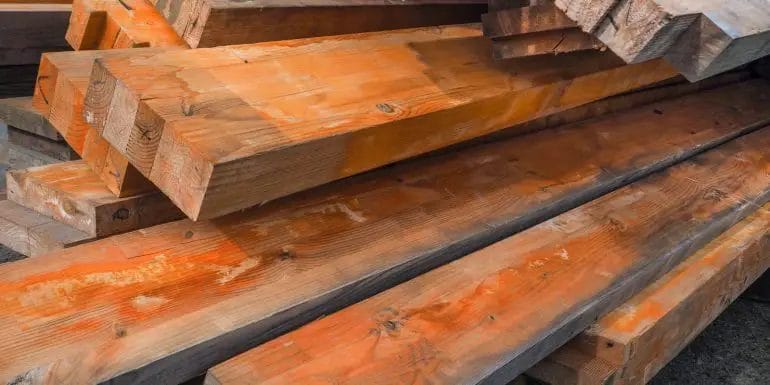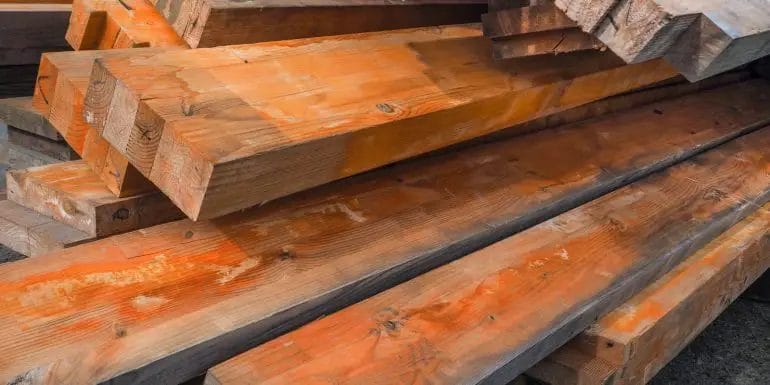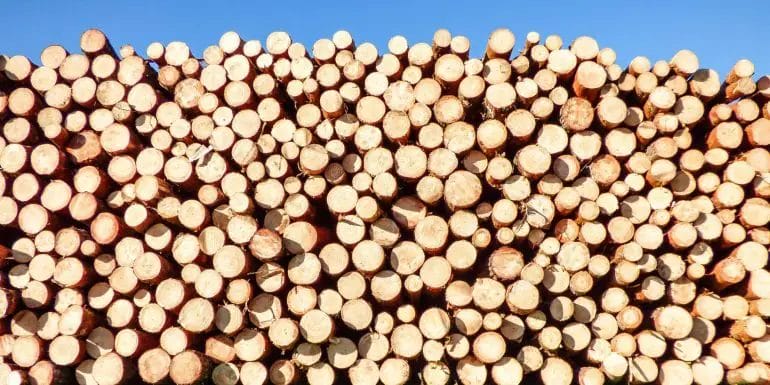Fireproofing wood is a crucial step in ensuring safety and preventing fire hazards. By treating wood with fire retardant materials, you can significantly reduce the risk of ignition and slow down the spread of flames.
There are various methods to make wood fireproof, such as using fire-resistant coatings, chemical treatments, or using fire-resistant building materials.

Fire-resistant coatings, like intumescent paint, create a protective layer that swells when exposed to heat, forming a barrier that insulates and shields the wood from fire.
Chemical treatments involve applying fire retardants that penetrate the wood’s surface and react with the cells, reducing its flammability.
Using fire-resistant building materials, like fire-rated gypsum board or cementitious boards, can also enhance wood’s fire resistance when used in construction or renovation projects.
Remember, while fireproofing wood can improve its resistance to flames, it is essential to follow local fire safety regulations and guidelines for maximum protection.

Choosing the Right Fireproofing Products for Wood
When it comes to protecting wood from fire, using fireproofing products is essential. These products are designed to reduce the flammability of wood and inhibit the spread of fire. However, with a wide range of options available in the market, choosing the right fireproofing product for wood can be a daunting task. In this section, we will discuss some key factors to consider when selecting fireproofing products for wood.
1. Fire Rating
The fire rating of a fireproofing product is an important factor to consider. It indicates the effectiveness of the product in preventing the spread of flames and heat. Fire ratings are determined based on standardized tests and are typically classified as Class A, Class B, or Class C. Class A fireproofing products offer the highest level of protection, while Class C products provide the lowest level of fire resistance. It is crucial to choose a fireproofing product with an appropriate fire rating based on the requirements of your project.
2. Application Method
Another important consideration is the application method of the fireproofing product. Different products require different application techniques, such as spraying, brushing, or rolling. The application method depends on various factors including the type of wood, the size of the project, and the desired finish. It is important to choose a product that can be easily applied and suits the specific requirements of your project.
3. Durability
The durability of the fireproofing product is a crucial factor, especially for wood that is exposed to outdoor conditions or high levels of humidity. The product should be able to withstand environmental factors and maintain its fire-retardant properties over time. Consider factors such as weather resistance, UV resistance, and moisture resistance when selecting a fireproofing product for wood.
4. Compliance with Building Codes
Ensure that the fireproofing product you choose complies with the relevant building codes and regulations. Different jurisdictions may have specific requirements for fire resistance in wood constructions. It is essential to select a product that meets the necessary standards and is approved for use in your area.
5. Cost-effectiveness
The cost of fireproofing products can vary significantly. It is important to evaluate the cost-effectiveness of the product based on its performance and durability. Consider the long-term benefits and the potential savings in terms of fire prevention and safety when making your decision.
6. Expert Advice
If you are unsure about which fireproofing product to choose, seek advice from experts in the field. Consult with fire safety professionals, architects, or contractors who have experience with fireproofing wood. They can provide valuable insights and recommend suitable products based on your specific requirements.
By considering these factors, you can make an informed decision when choosing fireproofing products for wood. Remember that the safety of your property and the people within it should be the top priority, so investing in reliable and effective fireproofing products is crucial.

Step-by-Step Guide to Fireproofing Wood
Wood is a versatile and commonly used material in construction and design. However, it is also highly flammable, posing a significant fire risk. Fireproofing wood is essential to ensure its safety and longevity. In this section, we will provide you with a step-by-step guide on how to fireproof wood effectively.
1. Choose the Right Fire Retardant
The first step in fireproofing wood is selecting the appropriate fire retardant. There are various fire retardant products available on the market, each with its own specifications and applications. It is crucial to choose a fire retardant that is specifically designed for wood and meets the necessary fire safety standards.
2. Prepare the Wood Surface
Before applying the fire retardant, it is important to prepare the wood surface. Start by cleaning the wood to remove any dirt, dust, or debris. Sand the surface lightly to create a smooth and even texture. This will help the fire retardant penetrate the wood effectively.
3. Apply the Fire Retardant
Using a brush or sprayer, apply the fire retardant to the wood surface. Make sure to follow the manufacturer’s instructions regarding the application method and coverage. Apply an even coat and ensure that all areas of the wood are adequately covered.
4. Allow Sufficient Drying Time
After applying the fire retardant, allow sufficient drying time as specified by the manufacturer. It is essential to ensure that the fire retardant fully dries and forms a protective barrier on the wood surface. Avoid exposing the treated wood to moisture or other elements during this drying period.
5. Repeat the Process (Optional)
Depending on the level of fire protection required, you may choose to repeat the fireproofing process. Applying multiple coats of fire retardant can provide enhanced fire resistance. Follow the manufacturer’s guidelines regarding the recommended number of coats and the drying time between each application.
6. Regular Maintenance
Fireproofing wood is not a one-time task. Regular maintenance is crucial to ensure the continued effectiveness of the fire retardant. Inspect the treated wood periodically to check for any signs of wear or damage. If necessary, reapply the fire retardant to maintain the wood’s fire resistance.
7. Additional Safety Measures
While fireproofing wood is an important step, it is also essential to incorporate additional safety measures. Install smoke detectors and fire extinguishers in the vicinity of the wood structures. Develop and practice a fire escape plan to ensure the safety of occupants in case of an emergency.
In summary, fireproofing wood is a critical step in enhancing its fire resistance. By following this step-by-step guide, you can effectively protect wood from the risks of fire. Remember to choose the right fire retardant, prepare the wood surface, apply the fire retardant correctly, allow sufficient drying time, and perform regular maintenance. Additionally, incorporate other safety measures to further enhance fire safety.

Common Mistakes to Avoid when Fireproofing Wood
Fireproofing wood is an essential step in ensuring the safety of structures and preventing the spread of fire. However, it is important to approach this process with caution and avoid common mistakes that can compromise the effectiveness of fireproofing efforts. In this section, we will explore some of the most common mistakes to avoid when fireproofing wood.
1. Choosing the wrong fire retardant product
One of the biggest mistakes people make when fireproofing wood is selecting the wrong fire retardant product. Not all fire retardants are created equal, and using the wrong product can lead to ineffective fireproofing. It is crucial to choose fire retardants that are specifically designed for wood and have been tested and approved for their fire-resistant properties. Conduct thorough research or consult with experts to ensure you select the right product for your specific needs.
2. Inadequate preparation
Proper preparation is key to achieving effective fireproofing results. Failing to prepare the wood surface adequately can result in poor adhesion of the fire retardant and reduce its effectiveness. Make sure to clean the wood surface thoroughly and remove any dirt, debris, or previous coatings. Additionally, sanding the surface can help create a better bond between the wood and the fire retardant, ensuring optimal protection.
3. Incorrect application
The way you apply the fire retardant product can significantly impact its effectiveness. One common mistake is applying the product too thinly or unevenly. This can result in areas with inadequate fire protection and compromise the overall fireproofing of the wood. Follow the manufacturer’s instructions carefully and apply the fire retardant evenly, ensuring complete coverage of the wood surface.
Another mistake to avoid is applying the fire retardant in unsuitable weather conditions. Extreme temperatures, high humidity, or wet surfaces can interfere with the product’s ability to adhere properly and achieve the desired fire protection. Choose a dry and moderate climate for applying the fire retardant to ensure optimal results.
4. Neglecting maintenance and reapplication
Fireproofing wood is not a one-time process. Over time, the effectiveness of the fire retardant may diminish due to wear, weathering, or other factors. It is essential to regularly inspect the fireproofed wood and perform any necessary maintenance or reapplication of the fire retardant. This will help ensure that the wood remains adequately protected and compliant with fire safety regulations.
5. Lack of professional assistance
Fireproofing wood can be a complex process, and it is advisable to seek professional assistance, especially for larger projects or structures. Professionals experienced in fireproofing techniques can provide valuable insights, recommend the most suitable products, and ensure that the fireproofing process is carried out correctly. Their expertise can help avoid costly mistakes and ensure the highest level of fire protection for the wood.
In summary, fireproofing wood is a critical step in safeguarding structures from fire hazards. By avoiding these common mistakes such as choosing the wrong fire retardant product, inadequate preparation, incorrect application, neglecting maintenance, and lack of professional assistance, you can enhance the effectiveness of your fireproofing efforts and protect the wood from potential fire risks.
Benefits of Fireproofing Wood and Ensuring Safety
Fireproofing wood is a critical step in ensuring safety in various settings. Whether it’s for residential, commercial, or industrial purposes, fireproofing wood offers numerous benefits that can help prevent the spread of fire and protect valuable assets. In this section, we will discuss the key benefits of fireproofing wood and how it contributes to overall safety.
1. Fire Resistance
The primary benefit of fireproofing wood is its enhanced fire resistance. By treating wood with fire-retardant materials, its ability to ignite and sustain fire is significantly reduced. This is crucial in minimizing the risk of fire accidents and limiting the damage caused by flames.
Fire-resistant wood also hinders the progression of fire, providing valuable time for evacuation and firefighting efforts. This is particularly important in buildings where a safe and swift evacuation is critical for saving lives.
2. Protection of Valuable Assets
Fireproofing wood is especially beneficial for structures that house valuable assets. Whether it’s a residential home with cherished belongings or a commercial building with expensive equipment, fireproofing provides an added layer of protection against fire-related damage and loss.
By reducing the flammability of wood, fireproofing helps safeguard assets from irreparable damage. This can save individuals and businesses from costly repairs, replacements, and insurance claims.
3. Compliance with Building Codes and Regulations
Fireproofing wood is often a requirement set by building codes and regulations. These safety guidelines are in place to ensure the wellbeing of occupants and mitigate the risk of fire incidents.
By adhering to these regulations, building owners and managers demonstrate their commitment to safety and decrease the liability associated with fire hazards. Failure to comply with fireproofing requirements can result in penalties, legal consequences, and even the closure of the building.
4. Extended Lifespan of Wood
Fireproofing treatments can also extend the lifespan of wood materials. By protecting wood from fire damage, decay, and insect infestations, fireproofing enhances the durability and longevity of the wood.
This is particularly beneficial for outdoor structures, such as decks and fences, that are constantly exposed to environmental elements. Fireproofing can help prevent premature deterioration and reduce the need for frequent repairs or replacements.
5. Peace of Mind
Perhaps one of the most significant benefits of fireproofing wood is the peace of mind it provides. Knowing that the wood used in a structure or furniture has been treated to resist fire offers a sense of security and reassurance.
Whether it’s in a residential or commercial setting, fireproofing wood allows occupants to feel safer and more confident in their surroundings. This peace of mind is invaluable and contributes to a positive living or working environment.
In summary, fireproofing wood offers numerous benefits that enhance safety and protect valuable assets. From its fire resistance properties to compliance with building codes, fireproofing ensures the longevity of wood materials and provides peace of mind. By investing in fireproofing measures, individuals and businesses can create a safer environment and mitigate the risks associated with fire incidents.
FAQs
1. How can I fireproof wood?
To fireproof wood, you can apply various fire retardant coatings or treatments that are specifically designed for wood. These coatings create a protective barrier, reducing the wood’s flammability and slowing down the spread of fire. It is important to carefully follow the instructions provided by the manufacturer when applying fireproofing products.
2. Can I make wood fireproof at home?
Making wood completely fireproof at home can be challenging. It is recommended to use commercially available fire retardant coatings or treatments that are specifically designed for wood. These products have been tested and certified to provide effective fire protection. DIY methods may not provide reliable fireproofing results.
3. Is treated wood fireproof?
Treated wood, such as pressure-treated lumber, has been chemically treated to resist decay and insect damage. While it offers improved resistance to fire compared to untreated wood, it is not completely fireproof. Additional fireproofing measures, such as using fire retardant coatings or treatments, may still be necessary for optimal fire protection.
Conclusion
In conclusion, fireproofing wood is a crucial step towards enhancing safety and protecting valuable assets. By following the recommended methods and techniques, such as applying fire retardant coatings and treating the wood with flame retardants, you can significantly reduce the risk of fire damage. Regular maintenance and inspections also play a vital role in ensuring the ongoing fire resistance of wood materials. Additionally, investing in fire-resistant building materials and designing fire-safe spaces can further enhance the overall fireproofing efforts. Remember, prevention is always better than dealing with the aftermath of a fire, so prioritize fireproofing measures to safeguard your property and loved ones.